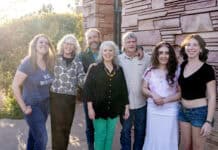The Taylor Fire, located approximately 13 miles southwest of Flagstaff, in Sycamore Canyon Wilderness near Turkey Butte, is expected to continue to intermittently generate smoke in Sedona and surrounding areas throughout the next several days.
The Coconino County Health Department would like to remind citizens that smoke generated by wildland fires can pose a health risk for some individuals. Certain precautions can be taken to protect you and your family from the effects of wildfire smoke.
According to a press release, wildfire smoke is primarily made up of small particles, gases and water vapor with trace amounts of hazardous air pollutants. Most harmful are the particles smaller than 2.5 micrometers in diameter; 70 micrometers is the diameter of a human hair. If these particles are inhaled deeply into the lungs, they can damage lung tissue and cause respiratory and cardiovascular problems.
Symptoms from short-term smoke exposure range from scratchy throat, cough, irritated sinuses, headaches, runny nose and stinging eyes to more serious reactions among persons with asthma, emphysema, congestive heart disease and other existing medical conditions.
Older adults and children are also high-risk groups. When smoke levels are dangerously high, the appropriate protective measures should be followed.
Ways to Protect Your Family’s Health from Wildfire Smoke
Pay attention to local air quality reports. Stay alert to any news coverage or health warnings related to smoke. Local health and emergency authorities will issue instructions based on the Environmental Protection Agency’s Air Quality Index.
Use visibility guides. Wildland fire smoke is highly visible. It is possible to visually estimate smoke levels and estimate potential health impacts. Generally, the worse the visibility is, the worse the smoke is. Use the following guide for determining air quality:
n Face away from the sun.
n Determine the limit of your visibility range by looking for targets at known distances. Visibility range is the point at which even high contrast objects totally disappear.
n Unusually sensitive people should consider reducing prolonged or heavy exertion.
n People with heart or lung disease, older adults and children should reduce prolonged or heavy exertion.
n Use common sense. If it looks smoky outside, it is probably not a good time for outdoor activities. And it’s probably not a good time for your children to play outdoors.
n If you are advised to stay indoors, keep your windows and doors closed. Make sure air conditioning units have a clean filter in the air intakes. Devices with High Efficiency Particulate Air filters can reduce the indoor pollution. Don’t use devices that generate ozone. Ozone creates even more pollution.
n Do not add to indoor air pollution. Don’t use anything that burns such as wood fireplaces, gas logs, gas stoves or even candles. Don’t vacuum. That stirs up particles already inside your home. Don’t smoke. That puts even more pollution in your lungs and in the lungs of people around you.
n Dust masks aren’t enough. Common masks will not protect your lungs from small particles in smoke. HEPA masks may filter out the small particles but are not suitable for people with lung diseases. Those with lung diseases should follow your respiratory management plan. Call your doctor if symptoms worsen.
For updated fire information, please call (928) 226-4600. Visit the Arizona Department of Health Services Web site at http://www.azdhs.gov/phs/oeh/wildfire.htm for additional information regarding the dangers of wildfire smoke and wildfire preparedness.
As an additional reminder, individual and family preparedness are important in many emergency situations including wildfire, floods and severe winter weather as well as contagious disease outbreaks.
Information regarding personal preparedness, including pandemic flu preparedness, is available by calling the CCHD at (928) 679-7272, toll free at (877) 679-7272 or by visiting www.coconino.az.gov/health.
